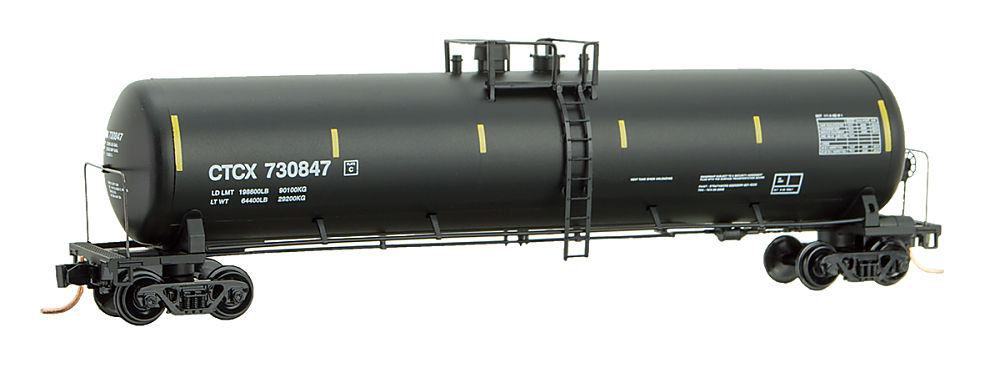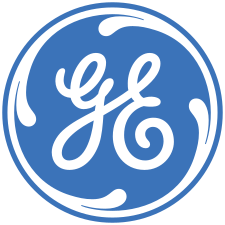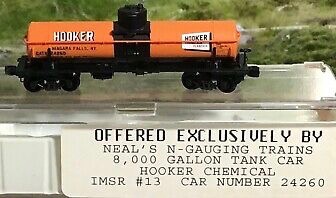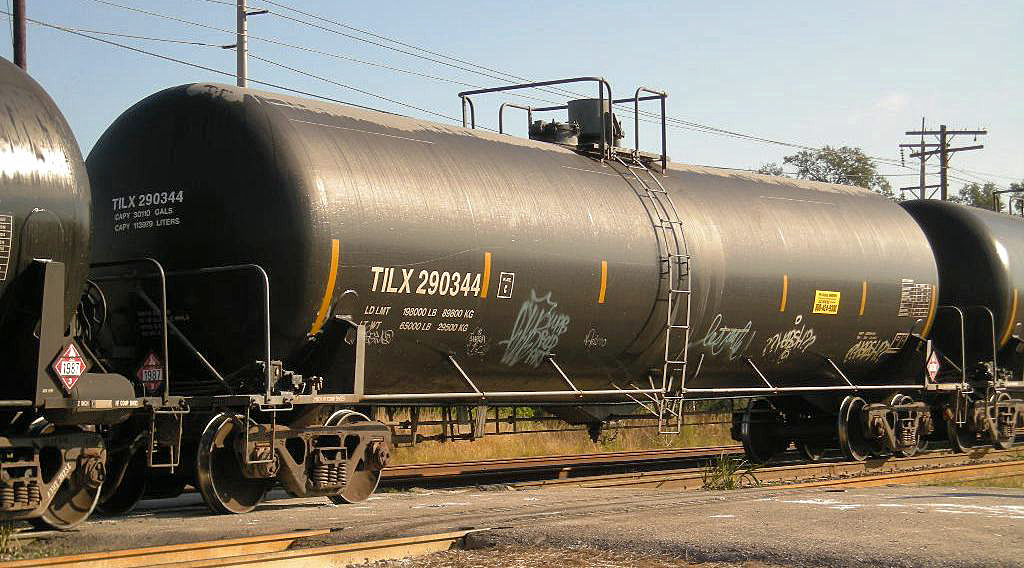Specific Item Information: It is common today to see miles of similarly marked tank cars snaking their way from the refineries to major distribution centers. As a safety measure, Buffer Cars, generally older covered hoppers, are placed at the head of the consist and at the rear providing crush space in case of an accident. This new 16-car set features two BNSF Airslide Hoppers converted to Buffer Cars and 14 modern CTCX tank cars giving the modeler a ready-to-run, movable pipeline for their layouts.
Model Information: Model Introduced: August, 2001. Era: 1970s to Present. It is a model of a DOT 111 A100 tank car.
Prototype History: Larger 50+ foot yank cars replaced their smaller predecessors in the late 1960s and 1970s. One example is the class DOT 111 A100. This car is rated for non-pressurized use with a safe maximum operating pressure of 100 psi. Developments in materials and manufacturing allowed this tanker to be constructed without an underframe. The bottom of the tank itself serves as the load bearing structure. The primary difference between the various types of DOT 111 A100 class tank cars is internal with varying types of insulation, lining and even weld material. Cars of this type haul a wide variety of commodities such as gasoline, vegetable oils, corn syrup, fruit juice and weed killers.
Road Name History: GE Capital Rail Services, also known as GE Railcar, or GE Railcar Services Corporation was a business unit of GE Capital, a division of General Electric. It is a distinct business unit from General Electric's railway locomotive manufacturer.
GE Rail Services offers leases and manages railcars (railway wagons) for the North American market; its product range includes all types of common freight wagon including box, flat, covered and uncovered hopper (gondola), and tank wagons. The company also manages service and repair of wagons.
In 1997, ACF (reporting marks: ACFX) reached leasing agreement with GE Capital Railcar for 35000 of its 46000 railcars, mostly on 16 year leases with optional purchase agreements.
In 2015 GE Capital announced the sale of its tank car and services business to Marmon Holdings, and the remainder of the business (other wagons, locos) to First Union Rail.
From Wikipedia
GE Rail Services offers leases and manages railcars (railway wagons) for the North American market; its product range includes all types of common freight wagon including box, flat, covered and uncovered hopper (gondola), and tank wagons. The company also manages service and repair of wagons.
In 1997, ACF (reporting marks: ACFX) reached leasing agreement with GE Capital Railcar for 35000 of its 46000 railcars, mostly on 16 year leases with optional purchase agreements.
In 2015 GE Capital announced the sale of its tank car and services business to Marmon Holdings, and the remainder of the business (other wagons, locos) to First Union Rail.
From Wikipedia
Brand/Importer Information: Micro-Trains is the brand name used by both Kadee Quality Products and Micro-Trains Line. For a history of the relationship between the brand and the two companies, please consult our Micro-Trains Collector's Guide.
Manufacturer Information:  Micro-Trains Line split off from Kadee Quality Products in 1990. Kadee Quality Products originally got involved in N-Scale by producing a scaled-down version of their successful HO Magne-Matic knuckle coupler system. This coupler was superior to the ubiquitous 'Rapido' style coupler due to two primary factors: superior realistic appearance and the ability to automatically uncouple when stopped over a magnet embedded in a section of track. The success of these couplers in N-Scale quickly translated to the production of trucks, wheels and in 1972 a release of ready-to-run box cars.
Micro-Trains Line split off from Kadee Quality Products in 1990. Kadee Quality Products originally got involved in N-Scale by producing a scaled-down version of their successful HO Magne-Matic knuckle coupler system. This coupler was superior to the ubiquitous 'Rapido' style coupler due to two primary factors: superior realistic appearance and the ability to automatically uncouple when stopped over a magnet embedded in a section of track. The success of these couplers in N-Scale quickly translated to the production of trucks, wheels and in 1972 a release of ready-to-run box cars.
Micro-Trains Line Co. split off from Kadee in 1990 to form a completely independent company. For this reason, products from this company can appear with labels from both enterprises. Due to the nature of production idiosyncrasies and various random factors, the rolling stock from Micro-Trains can have all sorts of interesting variations in both their packaging as well as the products themselves. When acquiring an MTL product it is very important to understand these important production variations that can greatly enhance (or decrease) the value of your purchase.
Please consult our Micro-Trains Collector's Guide

Micro-Trains Line Co. split off from Kadee in 1990 to form a completely independent company. For this reason, products from this company can appear with labels from both enterprises. Due to the nature of production idiosyncrasies and various random factors, the rolling stock from Micro-Trains can have all sorts of interesting variations in both their packaging as well as the products themselves. When acquiring an MTL product it is very important to understand these important production variations that can greatly enhance (or decrease) the value of your purchase.
Please consult our Micro-Trains Collector's Guide
Item created by: gdm on 2017-08-01 14:01:07. Last edited by George on 2024-01-26 20:29:06
If you see errors or missing data in this entry, please feel free to log in and edit it. Anyone with a Gmail account can log in instantly.
If you see errors or missing data in this entry, please feel free to log in and edit it. Anyone with a Gmail account can log in instantly.










